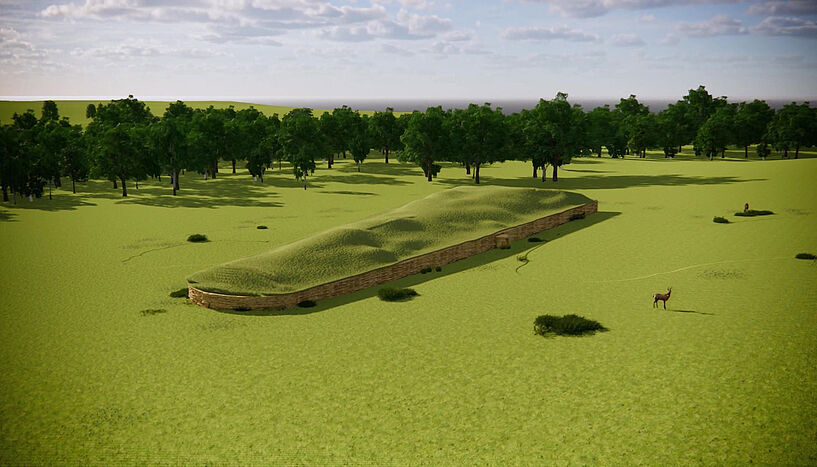World’s oldest family tree provides new insights into kinship and burial practices in Neolithic times
22. December 2021
Representation of the Hazleton long barrow in the landscape. (© Courtesy of Corinium Museum, Cotswold District Council)
A second paper sheds light on migrations into Bronze Age Britain
By analyzing ancient DNA an international team of scientists with participation of Ron Pinhasi’s team of the University of Vienna was able to retrace the world’s oldest family tree. They took samples from a Neolithic tomb in Britain. In their study published in Nature Communications they reveal undiscovered information about the structure of prehistoric families. Another study provides new insights about large-scale migrations into Bronze Age Britain.
Analysis of ancient DNA from one of the best-preserved Neolithic tombs in Britain has revealed that most of the people buried there were from five continuous generations of a single extended family. By analysing DNA extracted from the bones and teeth of 35 individuals, the research team was able to detect that 27 of them were close biological relatives. The group lived approximately 5700 years ago – around 3700-3600 BC - around 100 years after farming had been introduced to Britain.
Published in Nature, it is the first study to reveal in such detail how prehistoric families were structured, and the international team of archaeologists and geneticists, with participation of the University of Vienna, say that the results provide new insights into kinship and burial practices in Neolithic times. Most of those buried in the tomb were descended from four women who had all reproduced with the same man.
Complete absence of adult daughters
Research findings indicate that men were generally buried with their father and brothers. While two of the daughters of the lineage who died in childhood were buried in the tomb, the complete absence of adult daughters suggests that this community was patrilineal with males staying within the group, while female descendent offspring joins other groups.
The choice of where in the chambered tomb area individuals were buried initially depended on the first-generation woman from whom they were descended, suggesting that these first-generation women were socially significant in the memories of this community.
Of another eight individuals buried in the tomb, who were not related to those in the family tree, three were women and five were men. It is possible that the women could have had a partner in the tomb but either did not have any children or had daughters who reached adulthood and left the community so they are absent from the tomb. "Stepsons" were adopted into the lineage – males whose mother was buried in the tomb but not their biological father, and whose mother had also had children with a second male from the patriline.
Ron Pinhasi, of the University of Vienna, whose laboratory co-led the ancient DNA generation said: "It was difficult to imagine just a few years ago that we would ever know about Neolithic kinship structures. But this is just the beginning and no doubt there is a lot more to be discovered from other sites in Britain, Atlantic France, and other regions."
Insights about large-scale migrations into Bronze Age Britain
The first such discovery has been made by Pinhasi and his team themselves: in another major new study published in Nature, in collaboration with international researchers, the researchers analysed ancient DNA and traced the movement of people into southern Britain during the Bronze Age. People moving into southern Britain around 1300‒800 BC were responsible for around half the genetic ancestry of subsequent populations. It is the largest such analysis published to date, examined the DNA of nearly 800 ancient individuals.
"With this massive amount of data, we have for the first time the ability to carry out studies of adaptation with enough resolution in both time and space to allow us to discern that natural selection occurred in different ways in different parts of Europe," said Pinhasi. An unexpected finding of the study is the strengthening of lactase persistence in Bronze Age populations in Britain relative to the Continent. Since population movement often drives linguistic change, the new DNA evidence furthermore significantly strengthens the case for the appearance of Celtic languages in Britain in the Bronze Age – previously the subsequent Iron Age has been thought of as the period during which Celtic languages may have spread.
Publications in Nature:
'A high-resolution picture of kinship practices in an Early Neolithic tomb': Chris Fowler, Iñigo Olalde, Vicki Cummings5, Ian Armit, Lindsey Büster, Sarah Cuthbert7, Nadin Rohland, Olivia Cheronet9, Ron Pinhasi & David Reich
DOI: 10.1038/s41586-021-04241-4.
Large-Scale Migration into Britain During the Middle to Late Bronze Age: R. Pinhasi, D. Reich et.al.
DOI: 10.1038/s41586-021-04287-4
Scientific contact
Ron Pinhasi, PhD
Department für Evolutionäre AnthropologieUniversität Wien
1090 - Wien, Althanstraße 14 (UZA I)
+43-1-4277-547 21
+43-664-60277-547 21
ron.pinhasi@univie.ac.at
Further inquiry
Mag. Alexandra Frey
Media Relations ManagerUniversität Wien
1010 - Wien, Universitätsring 1
+43-1-4277-17533
+43-664-8175675
alexandra.frey@univie.ac.at
Downloads:
Abb._1_the_landscape__Courtesy_of_Corinium_Museum______R_Cotswold_District_Council__convert_01.jpg
File size: 418,38 KB
Abb._2_Cliffs_End_Farm_Kent_articulated_female_skeleton__Reproduced_with_permission_____R__Wessex_Archaeology__01.jpg
File size: 302,33 KB
Abb._3_Cliffs_End_Farm_Kent_burial_pit__Reproduced_with_permission_____R__Wessex_Archaeology__01.jpg
File size: 545,83 KB
